In the last light of the safari’s final day, Ian Batchelor and I followed blood and hoof prints into a thicket.
The buffalo could not be much further: both shots had hit well, and we had already trailed him nearly half a mile. William, the tracker, crouched low just behind us, his eyes on the trail; Ian and I watched the shadows ahead. When the bull came, he came in a sharp crackle of thornbush, a surging black mass in fading light. I don’t remember the sound of the guns. I remember William shouting, the black shape in the scope, the inverted feeling of shooting inbound, the flash of our rifles, the sight of the bull stopped cold at spitting range, still standing, then sinking to his knees with the next shots, and the sense that, for a moment, the world had stopped turning and would require a bit of effort to begin again.
That particular charge occurred a few years ago in Tanzania’s Maswa Game Reserve. Cape buffalo are not always like that, but I’ve never been bored hunting them. An old bull is a magnificent beast, as close a cousin to the prehistoric aurochs as can still be found on the planet. He combines good eyesight, a keen nose and superb hearing in a two thousand pound package that is as fast and agile as a cutting horse. And he’s unbelievably strong. That last bull turned out to have a broken shoulder and two bullets through the lower portion of his heart when he ran half a mile, waited for his moment, and charged. There is a pleasing directness about a buffalo: you generally get one good chance; in close cover perhaps a little less.
Amid the glow of the campfire and a toddy or two on the evening of that charge, Ian mentioned that his company was going to try to hunt the remote Matale hills near Lake Natron. As far as anyone could tell, it had never been hunted but was rumored to contain buffalo. Would I like to be the first to try it? Of course.
We spent the ensuing year putting the hunt together. Part of the fun was having no idea what to expect in Matale. We knew the terrain was rough and that access would have to be by horse and foot. Once the rains ended in June, Ian put together a small mobile camp for us at the end of the glorified cattle path that served as the only road into Matale. Our camp included Albie Kloppers, camp manager and trainer of our four horses, Singarian, an experienced tracker and gunbearer from the local Masai village, and a cadre of cooks, skinners and assorted camp workers. We planned to use the horses to get into the more remote areas and to pack out anything we might shoot. Most of the actual hunting would be on foot, primarily because a lot of the terrain in Matale is simply too thick for a horse: the hillsides are either loose rock or interwoven thornbush, and the deep ravines, called korongos, are covered with dense, jungle-like forest pierced by buffalo “tunnels” through which one alternately stoops and crawls.
For buffalo equipment, I took my pet .416 Rigby, my lucky buffalo hat (replete with lucky porcupine quill), and some handloaded 400 grain Barnes solids. The rifle has a low-powered scope that can be handy in differentiating black buffalo from black shadow in the dim light of a korongo. Ian carried an open-sighted .505 Gibbs, an absurdly short-barreled little cannon of German manufacture that spat flame at one end and bruising recoil at the other.
We scheduled the hunt for 10 days beginning in late August. When we arrived, we found the camp alive with horses, staff, and the distant sounds of bells and herdsmen’s cries as the Masai grazed their cattle and goats on the parched hills around us. After sighting in the guns, we talked about recent game reports. Most promising, we thought, were the requests from one of the local villages that we please do something about an old buffalo bull that had taken up residence near a spring where they watered their cattle. The bull had killed a Masai elder three years previously and had chased countless others since. By all accounts he was big, old and hated people. This was definitely interesting, and although it sounds in the retelling uncomfortably like the beginning of one of Capstick’s gaudier stories, that’s just the way it happened.
Around the fire that night we planned the morning’s campaign. “I think we’ll try picking up his tracks at first light near the spring,” Ian suggested. “The Masai say he drinks at night and then has three or four areas he likes to lie up in during the day. One thing you’ll need to be prepared for, Bob, is that with a bull like this in close cover, there might not be much chance to judge his horns. He’s definitely old, and he might be big, but if we find him he’s not going to like it. He might not give us much choice about shooting.” That sounded reasonable enough. We would take this bull as we found him, assuming we could find him at all.
Read the exciting ending of this story in the Autumn 2018 Guns & Hunting issue of Sporting Classics. Look on newsstands now or visit sportingclassics.com to start your subscription today.




